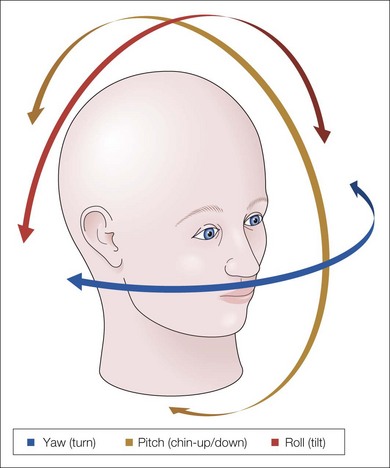Chapter 114 Practical problems
abnormal head postures
Introduction
We describe a practical approach to the patient presenting with an abnormal head posture (AHP).1,2,3 Chapter 81 details the causes, types, and physiologic basis of abnormal head postures.
Nomenclature
The three axes of rotation are “yaw” (about the vertical axis), “pitch” (about the anteroposterior axis), and “roll” (about the left-to-right axis) (Fig. 114.1). An AHP is described by these axes: yaw corresponds to head turn or face turn, pitch to head tilt, and roll to chin up or chin down.“Torticollis” refers to any abnormal head posture; sometimes, it is reserved for head tilt. “Compensatory head posture” is an AHP adopted to improve vision.
Characterization of the head position
Clinicians estimate the angle of head positions in degrees. Orthopedic goniometers (Fig. 114.2A), arthrodial protractors (Fig. 114.2B),4 and other devices including cervical range of motion devices (Fig. 114.2C)5 have been used to improve precision. Placing a prism (or yoked prisms) of increasing power in the line of sight until the head appears straight also may be used to measure the head position. Clinical photographs are a convenient, accurate, and reproducible way to document a head position (unpublished data). To obtain an accurate photograph, provide a target requiring fine visual resolution to ensure that the patient is fixating on the camera as the photograph is taken. Eliminate confounding background objects. Have a child sit up straight, off of the parent’s lap, to minimize leaning. Obtain similar photographs with each eye covered if head position changes with monocular viewing.
Stay updated, free articles. Join our Telegram channel

Full access? Get Clinical Tree




